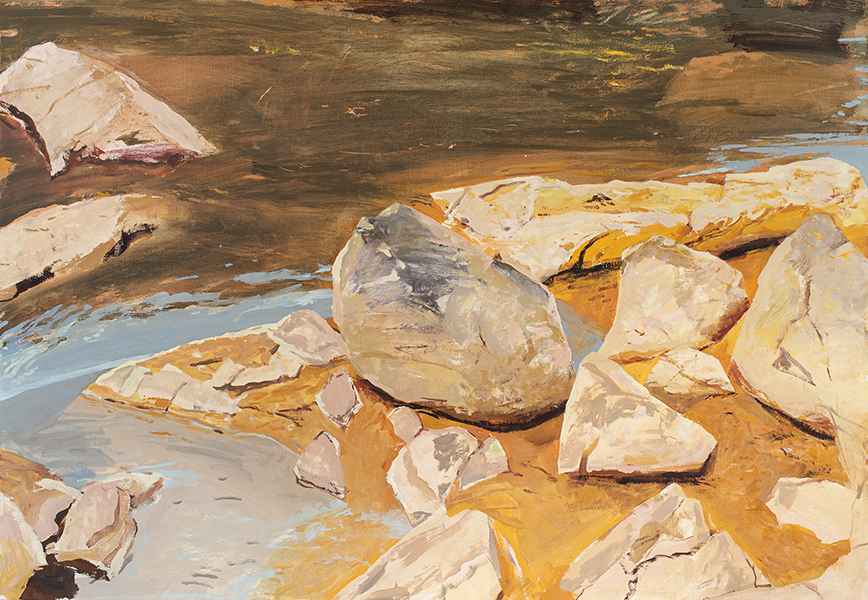 |
The back of one of my paintings, where the title goes.
You'll also see the stamp for the Grand Canyon
Celebration of Art, plus a location, date and time.
Finally, an inventory number, copyright year, title,
my name, and the month the painting was varnished. |
Here's a flashback:
I've just spent the last seven days at a plein air event painting like there's no tomorrow. Each day was the same. Rising before sunrise, wired up on coffee, I would drive to my first location—but not too fast, because hitting an elk would ruin my morning. After parking, I'd hike to a scenic overlook, not for the glorious sunrise, but to study the light and wonder how the shifting shadows might affect my composition. Then, quickly, I'd set up my gear and begin.
Later that morning, I'd begin again.
And that afternoon. And that evening, too.
And now, at the end of seven days, I'm beat. I've made more than two dozen paintings, some big, some small, and proud to say, there are only a couple of duds in the bunch. That means I need to frame and, yes, title, all those paintings.
Framing's not so hard, since I paint to a standard size, and with my handy point driver, it's just pop-pop-pop and it's done.
But titling? For many painters, this is the hardest part of painting. A painting needs a title, but why? The title goes on a little placard on the wall, with two goals. First, hopefully to reinforce the painting's theme. A sweet little painting of a tree bathed in the rich light of sunset might be called “Nature's Repose.” Second, to clarify any confusion the viewer might have about the painting. If that tree that might be misidentified as an ugly troll, making the viewer wonder why a fantasy painting was included in a plein air event, you might instead call it “Strangely Bent Tree on a High Cliff.”
These are two terrible titles, of course, but I only have a couple of hours to think up two dozen titles and then truck everything to the gallery.
Now, back to the present. I'm sure every painter under pressure struggles to come up with titles. And even when you have all the time in the world, it's still hard. How many of the paintings stacked up in your studio have the title0 “Sunset Colors” or something equally bland?
Paintings weren't always titled. Back in the Renaissance, when the only patrons were churches or wealthy merchants, the paintings were made as commissions and really didn't need titles. The cathedral required an altarpiece representing the usual characters. The merchant craved a painting depicting the happiness of his marriage. If any of these paintings have titles, they were most likely given by curators needing to identify them centuries later with something other than a museum accession number. Hence, we have titles like “The Ghent Altarpiece” and “The Arnolfini Wedding.” The title of any one painting could change over time, depending on who was in charge. For example, “The Arnolfini Wedding” may also be found as “The Arnolfini Marriage” and “Portrait of Giovanni Arnolfini and his Wife.”
It wasn't until the 19th century, when painters stopped being thought of as craftsmen belonging to a guild and instead were honored as individual artists, that they began titling their paintings, and with a purpose. Whistler named one of his paintings “Arrangement in Grey and Black, No. 1: Portrait of the Painter’s Mother” because he wished to draw attention to its design and colors rather than to the subject. I think he added “Portrait of the Painter's Mother” because he wanted to be a good son, not because that fact was particularly important.
There are three ways to title a landscape painting:
- By description. In this case, the painter emphasizes that either the location or the subject is important to the viewer's understanding. Examples: “The Hay Wain” or “Domes of Yosemite.”
- By inventory number. Here, the painter depends on the viewer to come up with his own idea of what the painting may mean. Example: “Number 6.”
- By literary title. The painter may try to stir up the romantic spirit in the viewer, or a feeling of mystery, awe, etc. Examples: “A Dream of Spring.”
Over the years, I've used all three. During plein air events, I usually resort to the first; the patrons at these events often want to know where a painting was made and what it depicts. Over time, of course, one tires of the variations: “Mather Point, Sunset,” “Mather Point, Sunrise,” “Mather Point, Evening Glow.” Out of laziness, I've sometimes used the second method, simply assigning numbers plus a much abbreviated description: “Fall Tree #43.” This caused a problem once. I had a piece juried into a competition, and what I mistakenly took to the show was a painting with a very similar name but a different scene. It didn't match the slide I'd sent in at all. (No one noticed.)
I do love the third method best, as it appeals to the writer in me. But it is very hard to come up with meaningful titles time and again. Writers often use phrases from Shakespeare to title their works; I decided at one time to try Grateful Dead lyrics.
These days, I have started focusing more on the painting and not so much on the title. My titles are more descriptive.
I'm curious: What are your thoughts on titles?









